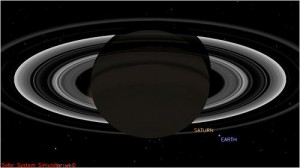ELSI Blog
8 The Day Earth Smiled
Do you know what you will be doing on July 19th 21:27 to 21:42 UTC, or July 20th 6:27 to 6:42 JST? Most of us will live those 15 minutes in ordinary ways but it will be a special time for Earth. Far away, at a distance of more than a billion kilometers away from our home, the NASA's Cassini spacecraft will take a picture of the Earth. This will not be an ordinary picture: because of the enormous distance, the whole Earth will cover only one pixel, or more precisely, only a part of one pixel. The occasion will be a special one: Cassini will be in the shadow of Saturn, so it will not be blinded by sunlight, and it will be safe to take a picture of Earth.
Unfortunately Japan will not be facing Saturn during this period, so we will not be able to "wave at Saturn" but as a citizen of the Earth, I find this event awe-inspiring. To celebrate this rare event, here are some projects are being planned: http://thedaytheearthsmiled.com/info.php#projects

Simulated view from NASA's Cassini spacecraft that shows the expected positions of Saturn and Earth on July 19, 2013 when Cassini will take Earth's image. Image credit: NASA/JPL-Caltech
This is the third time for us to glance back at Earth from the outer Solar System. The first image was taken by NASA's Voyager 1 spacecraft from 6 billion kilometers away. This image inspired Carl Sagan's famous three words, "pale blue dot", which Piet's previous blog talks about. The second was taken by Cassini in 2006.
Each time, these images have given us a glimpse of "our world" in a scale that we do not think about every day. You may be busy working, you may be laughing, or you may be fighting against someone/thing, but we are individuals living our lives on a tiny single spot in the Solar System. We feel our self-importance but who in space would guess we are here? Seeing these images opens up our imagination for the possibility of something greater than what we experience in our daily lives and what we learn from the literature on our Solar System and beyond.
When I see our planet from billions of kilometers away, one question comes to my mind: how would we guess the presence of life and the rich nature that sustains that life on Earth-twins, planets that are similar to the Earth, from astronomical distances? Such a question is now well-motivated, because the abundance of Earth-size exoplanets have been implied from observations which detect the reflex motion of the Star by the planet, the periodic decrease of starlight due to the transit of the planet, or the anomaly of gravitational microlensing events due to the planet.
In the future, we should be able to image planetary light directly to obtain further information of potentially habitable exoplanets. Currently, techniques of direct imaging of Earth-size planets are under development, and several projects are being discussed around the world. For instance, a coronagraph instrument to go with the Thirty Meter Telescope is being proposed by a Japanese group in which I am also participating. (The PI of this project is Prof. Taro Matsuo.)
As a benchmark for future imaging of exoplanets, characteristics of the Earth as a single dot have been a subject of study for more than a decade. In principle, colors, spectra, and their time variations will provide essential hints for surface environment of potentially habitable planets including the atmospheric composition, spin rate, and surface composition. Features of the Earth include those which originate from bioactivity such as oxygen, its photochemical product ozone, and our vegetation's peculiar reflection spectra. These features are expected to work as probes of "inhabited worlds" in future exoplanet investigations.
Besides, we may be able to obtain a map of the globe by observing the change in the averaged color of the planet due to the spin rotation (and orbital revolution), based on the characteristic colors of materials -- clouds are white, continents are brown, ocean is dark blue, for instance. Together with my collaborators I demonstrated the recovery of rough distributions of continents/clouds/snow/vegetation from time-series of Earth's color.
Thus we are getting ideas of which features among the complex nature on Earth would be knowable from "a pale dot" observation. In the same way that the pale blue dot of our Earth is filled with the richness of life, a tiny pixel of imaging is filled with the richness of information that can tell us about our planet and also give us clues on how to look for life on other planets. Knowledge of life on our planet as observed from a distance to advance the search for life in our Solar and Exosolar system is one of ELSI's research goals.











